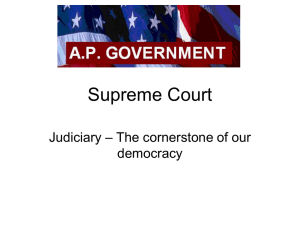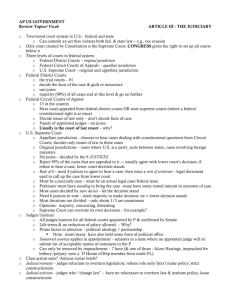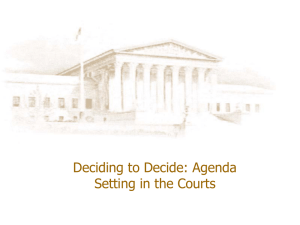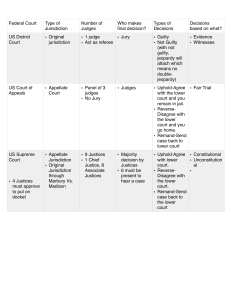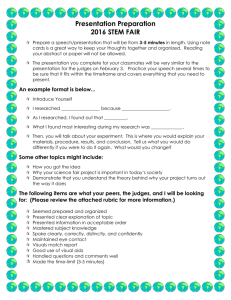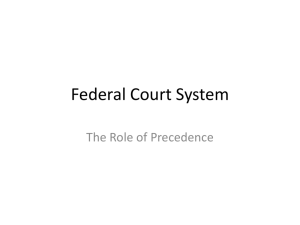Supreme Court - Fort Thomas Independent Schools
advertisement
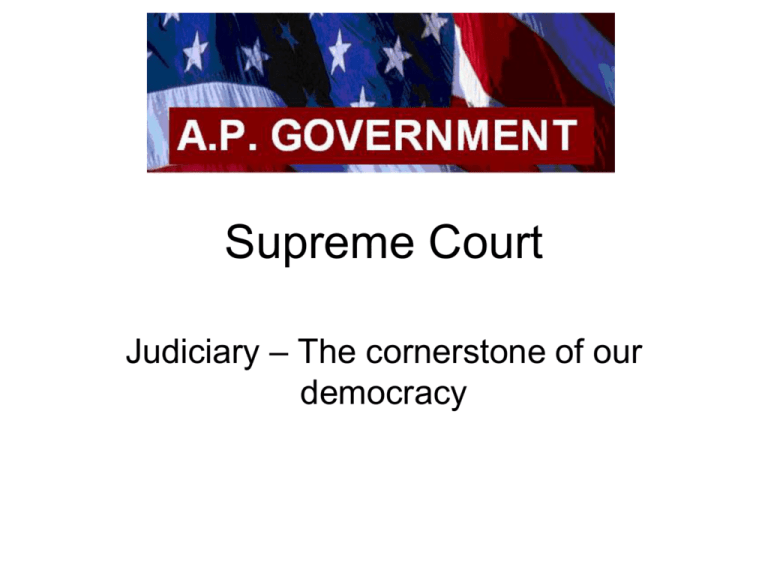
Supreme Court Judiciary – The cornerstone of our democracy Judicial Review • Marbury v. Madison (1803) – Allows the courts to rule on the constitutionality of laws, giving the court the power to strike down or reinforce policy – Judiciary Act of 1789 and the writ of mandamus Federal Court System • Step 1 – DISTRICT COURTS – 94 US Dist. – Hear 342,000 cases/yr – Trial by jury (only federal court with jury) – Judge David Bunning sits at this level • Step 2 – APPEAL (CIRCUIT) COURTS – 12 Courts of Appeal – Hear 61,000 cases/yr – Panel of 3 judges, sometimes more – No cases start here, review district court decisions – (MI, OH, KY, TN in the 6th District) Federal Court System • Step 3 – US Supreme Court – 2013 – plenary review with oral arguments in about 100 cases – 5000 petition the court but most are denied – 80-90 opinions written; 50-60 cases decided without oral arguments – Cases audio recorded and released on www.oyez.org – Hear appeals – writ of certiorari – Very few “original jurisdiction” cases (they hear it first) – Rule of 4 – 4 justices needed to agree to hear a case The Roberts Court Chief Justice John Roberts Types of Opinions • When an opinion is written (a decision), it often takes months and many drafts – Majority Opinion – justices in the majority must draft an opinion setting out the reasons for their decision – Concurring Opinion – justices who agree with the end result, but not the legal logic, of the majority can give their opinion – Dissenting Opinion – justices who disagree with the opinion write their side – can be one dissent or multiples depending on legal logic Implementation • The court is only as powerful as the president that will enforce its decisions. • “John Marshall has rendered his decision; now let him enforce it!” – Andrew Jackson • Refused to enforce Cherokee land rights; resulted in the “Trail of Tears” – his successor Martin Van Buren eventually carried out the removal • “All deliberate speed” – Chief Earl Warren – 10 years after Brown only 1% of Southern schools were desegregated – Eisenhower & JFK sent army south to desegregate • Court must rely on other branches, state & local officials and law enforcement agencies to enforce its ruling Public Influence on Justices • • 1. 2. Justices are NOT elected, appointed by President However, not entirely immune to public opinion Since they were appointed by a specific president, they generally agree with his ideologies. Justices are aware of public opinion, and are aware that decisions that flagrantly go against public opinion will not be implemented or will be subverted by the legislative or amendment process Conservatism vs. Liberalism??? • Justices are supposed to be “above politics” and maintain impartiality • However, they do have personal ideologies or biases – EX. – CJ Earl Warren (1953-69) and CJ Warren Burger (1969-1986) were very liberal – CJ William Rehnquist (1986-2005) and CJ John Roberts (2005-?) lean conservative Appointment • President appoints judges for ALL federal court vacancies • Senate must confirm all nominations by majority vote (Advice and consent) • Senatorial courtesy – tradition started by G.Washington to seek approval from local senators over locally appointed judges Types of Jurisprudence Adversarial system – • “Blind justice” - decision must be made between 2 choices (defense vs. prosecution – each presents its side of the case) • court can’t bring up an issue - court maintains impartiality and the jury weighs the evidence • 5th Amendment - defendant doesn’t have to testify against oneself -we use this system in the US Types of Jurisprudence • Inquisitorial system • presumed guilty unless you can prove innocence • court is actively involved in pursuing facts/investigating the case • European (Roman/Napoleonic code) model • judge questions the defendant to try to get them to admit guilt • defendant can present their side of the story w/out being cross-examined; think Amanda Knox case in Italy – she was found guilty again last week (3rd trial) • Remember World Civ. “Spanish Inquisition” Constraints on the Court • Justiciable dispute – must judge actual situations, not hypothetical situations (aka Live Controversy rule) no “What if we passed a law about ____? Is it Constitutional? • Political question – absence of existing law makes it difficult for the court to rule on a case; won’t hear a case until a law has been passed regarding the issue • Ex. – anti-gay marriage laws in the past 10 years the court to heard those cases in March of 2013. More on those decisions next week. Checks on SCOTUS • President appoints all judges • Senate must confirm appointed judges • Congress may alter the structure of the court system (add or subtract # of courts and justices) • Congress has the power to impeach judges • Congress may amend the Constitution if the Courts find a law unconstitutional – Ex. Income tax law originally found unconstitutionally so Congress added 16th amendment in 1913 Judicial and Political Philosophy Intersect Judicial Activism Judges should interpret law loosely, using their power to promote their preferred political and social goals. Judges are said to be activists when they are likely to interject their own values in court decision Equality Liberal Freedom Order Leans to the left on public policy and would vote Democrat Conservative Leans to the right on public policy and would vote Republican Freedom Judicial Restraint Legislators, not judges, should make the laws. Judges are said to exercise judicial restraint when they rule closely to statutes and previous cases when reaching their decisions. They follow the “original intent” of the framers.

